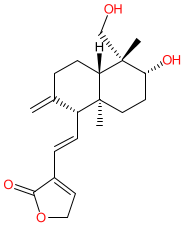GtoPdb is requesting financial support from commercial users. Please see our sustainability page for more information.
|
Synonyms: ddA (14-deoxy-11,12-didehydroandrographolide) [2]
Compound class:
Natural product
Comment: This is a labdane-type diterpenoid isolated from the herbaceous plant Andrographis paniculata. Experimental evidence points to its action as a transient receptor potential vanilloid subtype 3 (TRPV3) ion channel inhibitor/antagonist [2].
Ligand Activity Visualisation ChartsThese are box plot that provide a unique visualisation, summarising all the activity data for a ligand taken from ChEMBL and GtoPdb across multiple targets and species. Click on a plot to see the median, interquartile range, low and high data points. A value of zero indicates that no data are available. A separate chart is created for each target, and where possible the algorithm tries to merge ChEMBL and GtoPdb targets by matching them on name and UniProt accession, for each available species. However, please note that inconsistency in naming of targets may lead to data for the same target being reported across multiple charts. ✖ |
|
|||||||||||||||||||||||||||||||||||
| Bioactivity Comments |
| In vivo this compound is antipruritic in rodents with itch induced by the TRPV3 activator carvacrol, and it suppresses histamine-induced itch with efficacy comparable to the anti-histamine drug loratadine. It is not cytotoxic. |
| Selectivity at ion channels | ||||||||||||||||||||||||||||||||||
| Key to terms and symbols | Click column headers to sort | |||||||||||||||||||||||||||||||||
|
||||||||||||||||||||||||||||||||||








